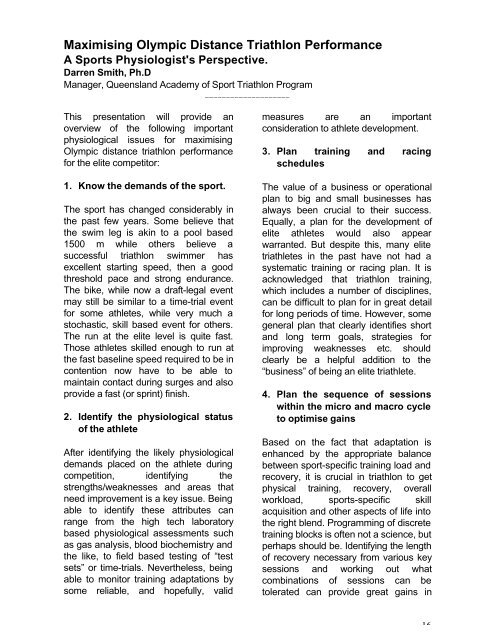MAXIMISING OLYMPIC DISTANCE TRIATHLON PERFORMANCE ...
MAXIMISING OLYMPIC DISTANCE TRIATHLON PERFORMANCE ...
MAXIMISING OLYMPIC DISTANCE TRIATHLON PERFORMANCE ...
You also want an ePaper? Increase the reach of your titles
YUMPU automatically turns print PDFs into web optimized ePapers that Google loves.
Maximising Olympic Distance Triathlon PerformanceA Sports Physiologist's Perspective.Darren Smith, Ph.DManager, Queensland Academy of Sport Triathlon Program____________________This presentation will provide anoverview of the following importantphysiological issues for maximisingOlympic distance triathlon performancefor the elite competitor:1. Know the demands of the sport.The sport has changed considerably inthe past few years. Some believe thatthe swim leg is akin to a pool based1500 m while others believe asuccessful triathlon swimmer hasexcellent starting speed, then a goodthreshold pace and strong endurance.The bike, while now a draft-legal eventmay still be similar to a time-trial eventfor some athletes, while very much astochastic, skill based event for others.The run at the elite level is quite fast.Those athletes skilled enough to run atthe fast baseline speed required to be incontention now have to be able tomaintain contact during surges and alsoprovide a fast (or sprint) finish.2. Identify the physiological statusof the athleteAfter identifying the likely physiologicaldemands placed on the athlete duringcompetition, identifying thestrengths/weaknesses and areas thatneed improvement is a key issue. Beingable to identify these attributes canrange from the high tech laboratorybased physiological assessments suchas gas analysis, blood biochemistry andthe like, to field based testing of “testsets” or time-trials. Nevertheless, beingable to monitor training adaptations bysome reliable, and hopefully, validmeasures are an importantconsideration to athlete development.3. Plan training and racingschedulesThe value of a business or operationalplan to big and small businesses hasalways been crucial to their success.Equally, a plan for the development ofelite athletes would also appearwarranted. But despite this, many elitetriathletes in the past have not had asystematic training or racing plan. It isacknowledged that triathlon training,which includes a number of disciplines,can be difficult to plan for in great detailfor long periods of time. However, somegeneral plan that clearly identifies shortand long term goals, strategies forimproving weaknesses etc. shouldclearly be a helpful addition to the“business” of being an elite triathlete.4. Plan the sequence of sessionswithin the micro and macro cycleto optimise gainsBased on the fact that adaptation isenhanced by the appropriate balancebetween sport-specific training load andrecovery, it is crucial in triathlon to getphysical training, recovery, overallworkload, sports-specific skillacquisition and other aspects of life intothe right blend. Programming of discretetraining blocks is often not a science, butperhaps should be. Identifying the lengthof recovery necessary from various keysessions and working out whatcombinations of sessions can betolerated can provide great gains in16


